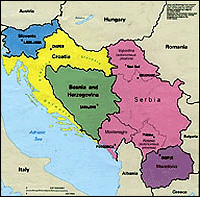Socialist Federal Republic of Yugoslavia 1963 The nation changed its name, each republic and province had its own internal constitution, supreme court, parliament, president and prime minister. At the top of the Yugoslav government was a collective Presidency, the federal Prime Minister, and the federal Parliament. An important role was one of the president of the Communist Party of Yugoslavia for each republic and province, and the president of presidency of Central Committee of the Communist Party.
1980 Ethnic tensions grew in Yugoslavia. Some members of the Serbian Academy of Sciences and Arts drafted a memorandum in the 1980s that opposed the policy of the federation and promoted Serbian nationalism in response to the growing influence of the religious clerics chiefly in Croatia and Slovenia.
Serbian communist leader Slobodan Milosevic, the new strong man of Yugoslavia, tried to play on the revived Serb nationalism, but ended up alienating all the other ethnic groups in the federation.
1991 Following the fall of the Soviet Union in the rest of Eastern Europe, each of the republics elected a new government democratically, but the unresolved issues remained. In particular, Slovenia and Croatia elected governments oriented towards independence while Serbia and Montenegro elected candidates who favored Yugoslav unity.
The origins and causes of the inherent ethnic, political, and religious conflicts and antagonisms in Bosnia were ultimately caused by the mutually exclusive national and political agendas of the three Bosnian factions: the Bosnian Serbs (Orthodox Christian), the Bosnian Muslims, and the Bosnian Croats (Roman Catholic), all Slavic and all speaking Serbo-Croatian, but all divided by religion, by culture, and differing national visions.
The Bosnian Muslims sought to secede from Yugoslavia but yet to maintain Bosnian borders and the political structure as it had existed in the Yugoslav federation.
The Bosnian Serbs perceived that the destruction of the Yugoslav federation would necessarily result in the destruction of what it maintained and instituted, the Bosnian Republic, Bosnia-Herzegovina. If Yugoslavia was destroyed, then the internal borders that Yugoslavia created would be destroyed.
The Bosnian Croats wanted first to detach Bosnia from the Yugoslav federation and then to create their own Croat mini-state, Bosna-Herzegovinia, which would unite with Croatia.
These three mutually exclusive and antagonistic agendas were at the root of the conflict and the crisis.
